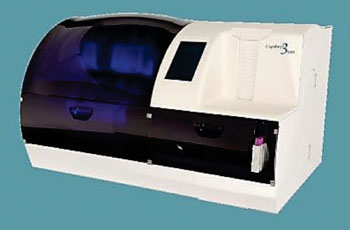Alpha-Thalassemia Affects HbA1c Measurement
By LabMedica International staff writers
Posted on 01 Jun 2016
A major glycated hemoglobin, known as HbA1c, is characterized by non-enzymatic binding of glucose to the N-terminal valine residue of the hemoglobin b-chain, is a widely used biomarker in the management of diabetes.Posted on 01 Jun 2016
α-Thalassemia is a benign condition that is seen some in patients with diabetes mellitus and is due to impaired production of alpha chains from 1,2,3, or all 4 of the alpha globin genes, leading to a relative excess of beta globin chains. The degree of impairment is based on which clinical phenotype is present.

Image: The capillary electrophoresis system for HbA1c measurements (Photo courtesy of Sebia Benelux).
Clinical medical scientists at the Peking University Shenzhen Hospital (Guangdong, China) tested a total of 189 EDTA whole blood samples from all patients for complete blood counts with red cell indices and HbA2 using an XN9000 analyzer (Sysmex Corporation, Kobe, Japan) and hemoglobin capillary electrophoresis (Sebia Benelux, Vilvoorde, Belgium). Samples were separated into several aliquots and frozen at -80 °C before HbA1c analysis.
Plasma samples were tested for fasting glucose (FG), albumin, fructosamine, and ferritin immediately after centrifugation. The effects of the number of functionalα-genes on HbA1c measurement was investigated by boronate affinity high-performance liquid chromatography (HPLC; Ultra²; Trinity Biotech, Kansas City, MO, USA).
In patients with two or three functional α-genes, HbA1c values were not significantly different from those of controls; however, in individuals with α-thalassemia with one functional α-gene (i.e., HbH disease), HbA1c levels were significantly different from those of controls. HbA1c values were significantly lower in individuals with HbH disease than in control individuals and patients in the other two α-thalassemia groups. For patients with HbH disease, there were no significant differences in the four HbA1c measurement systems.
The authors concluded that HbA1c values in samples from individuals with two or three functional α-genes basically reflected the normal mean blood glucose level, while those in samples from individuals with one functional α-gene did not. Therefore for patients with HbH disease, HbA1c values cannot be used for the assessment of diabetes because HbA1c values do not reflect the mean blood glucose level. The study was published on May 17, 2016, in the Journal of Clinical Laboratory Analysis.
Related Links:
Peking University Shenzhen Hospital
Sysmex
Sebia Benelux
Trinity Biotech













